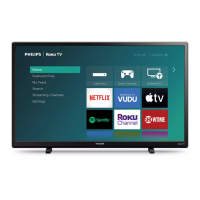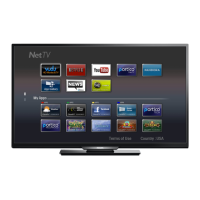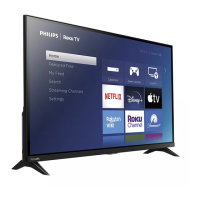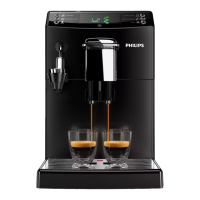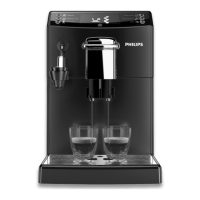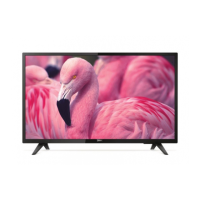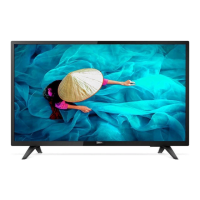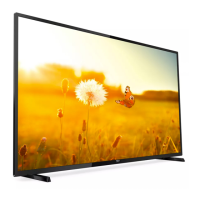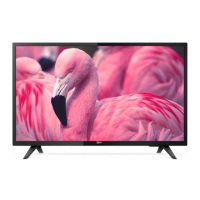Do you have a question about the Philips HD TV and is the answer not in the manual?
Overview of TV capabilities including HD display, 3D viewing, and Smart TV applications.
Details media playback, program guides, EasyLink for device control, and Ambilight ambient lighting.
Details the physical buttons and ports on the back of the television.
Explains the functions of all buttons on the remote control for TV operation.
Critical safety instructions for preventing electric shock, fire, and injury during TV use.
Instructions for cleaning and maintaining the TV screen to prevent damage.
Legal notices, copyright information, and disclaimers regarding product specifications and manual content.
Details the product warranty conditions and what may void it.
Covers pixel characteristics, CE/EMF compliance, and trademarks.
Features designed for energy saving, including picture settings and screen-off options.
Information on product recyclability and disposal according to directives.
Information about the European Union Ecolabel and its meaning for the TV.
Explains the European Energy Label for product energy efficiency class and consumption.
Instructions on accessing Philips support website for manuals, FAQs, and contact information.
Instructions on switching the TV on/off, standby mode, and adjusting volume.
Details the TV's auto-switch-off feature and how to disable it for energy saving.
How to switch channels using the remote control or numeric buttons.
How to rename, reorder channels, and listen to digital radio.
How to select input sources from the Home menu or Source menu.
How to choose picture and sound settings like Vivid, Cinema, Game, or custom.
Options to adjust the picture aspect ratio (e.g., Auto fill, Wide screen) for different content.
How to access and view TV channel schedules and program information from broadcasters.
How to set up, access, and customize TV program guides from broadcasters.
Information on 3D viewing requirements, content selection, and activation.
Steps to begin 3D viewing, adjust formats, and switch back to 2D.
How to play videos, photos, and music from a USB device with playback controls.
Controls for music and picture slideshow playback, including options and settings.
How to access Smart TV apps and connect the TV to the internet.
Steps to start Smart TV, access apps, browse websites, and use zoom/scroll functions.
Information about using interactive TV features and their requirements.
Details on optimizing Ambilight effect and turning it on.
How to adjust Ambilight color, brightness, and separation for personalized effects.
How to add game consoles and configure TV settings for gaming.
Guides on starting two-player games and managing split-screen views.
How to select pages, use options, and search within teletext broadcasts.
Setting teletext language and using digital teletext features.
Details on using Teletext 2.5 for improved graphics and how to enable/disable it.
How to manage the TV clock, set a sleep timer, and adjust related preferences.
Instructions for setting up and managing the child lock feature to restrict content.
How to lock channels and set parental ratings to control program access.
Overview of EasyLink features for controlling HDMI-CEC devices and setup requirements.
Steps to switch on EasyLink, control devices simultaneously, and use remote buttons.
How to select audio output sources for TV speakers and connected devices.
How to output TV audio through HDMI ARC devices.
Setting up audio delay and using Pixel Plus Link for improved viewing.
How to enable auto subtitle shift for better subtitle visibility.
Overview of professional mode features for hotel use and how to enter it.
How to change menu language, UI source, Room ID, and Smart TV settings.
How to configure web services and customize TV switch-on settings.
How to manage guest access and set up custom welcome messages.
How to manage power modes, energy saving, and clock display settings in professional mode.
Details on various other professional mode settings for TV behavior and security.
How to set up features like Multi RC, Theme TV, and adjust speaker settings.
How to reset TV settings and manage channel lists, including locking and reordering.
Steps to install analog and digital TV channels (DVB-T/T2, DVB-C).
How to clone TV settings and perform software updates via RF or IP.
Guidance for installers on accessing TV setup menus.
Comprehensive guide to adjusting various picture settings for optimal viewing.
How to fine-tune sound parameters like bass, treble, and volume for different audio experiences.
How to select preferred audio formats for digital TV channels.
Steps to reset picture and sound settings to factory defaults.
Managing channel list updates, including automatic and manual methods.
How to disable channel update messages and automatic updates.
How to choose preferred audio languages for digital channels.
Enabling and configuring features for hearing and visually impaired users.
How to select audio output, adjust volume, and enable feedback for visually impaired users.
How to set TV location (Home/Shop mode) and restore default settings.
Importance of cable quality and details on using HDMI for best picture and sound.
How to connect devices using Y Pb Pr component video and SCART cables.
Details on using SCART for RGB video and VGA for PC display.
How to connect Blu-ray or DVD players using HDMI cables.
How to connect disc players using component video (Y Pb Pr) and audio cables.
Steps to connect TV receivers via antenna or HDMI cables.
How to connect TV receivers using SCART or component video cables.
Steps to connect a video recorder using an antenna cable.
How to connect recorders using SCART or component video cables.
Steps to connect game consoles using HDMI cables for optimal performance.
How to connect game consoles using component video (Y Pb Pr) and audio cables.
How to connect home theater systems via HDMI/optical or SCART cables.
How to connect home theater systems using component video and audio cables.
Steps to connect digital cameras via USB and camcorders via HDMI.
How to connect digital camcorders using component video and audio cables.
How to connect external speakers and set-top boxes to the TV.
Steps to connect USB hard drives to the TV for media access.
How to connect computers to the TV using HDMI for display.
How to connect computers using DVI-HDMI or VGA with audio cables.
Connecting and using USB keyboards and mice with the TV for navigation and text entry.
Instructions for using USB mice and keyboards with the TV for navigation and text entry.
How to add new devices to the Home menu for easy access and viewing.
Steps to add new devices to the TV and rename them in the Home menu.
How to select connected devices from Home/Source menus and remove them.
Details on power requirements, energy consumption, and TV reception capabilities.
Technical details on picture display, resolution, aspect ratio, and sound output.
List of video resolutions and refresh rates compatible with the TV.
Details on supported multimedia file types, codecs, and playback capabilities.
Details on supported audio file types and subtitle formats with character encoding.
Lists all available rear and side connectors for device connections.
Guidelines for selecting compatible TV mounts, VESA sizes, and screw lengths for safe wall mounting.
Overview of TV capabilities including HD display, 3D viewing, and Smart TV applications.
Details media playback, program guides, EasyLink for device control, and Ambilight ambient lighting.
Details the physical buttons and ports on the back of the television.
Explains the functions of all buttons on the remote control for TV operation.
Critical safety instructions for preventing electric shock, fire, and injury during TV use.
Instructions for cleaning and maintaining the TV screen to prevent damage.
Legal notices, copyright information, and disclaimers regarding product specifications and manual content.
Details the product warranty conditions and what may void it.
Covers pixel characteristics, CE/EMF compliance, and trademarks.
Features designed for energy saving, including picture settings and screen-off options.
Information on product recyclability and disposal according to directives.
Information about the European Union Ecolabel and its meaning for the TV.
Explains the European Energy Label for product energy efficiency class and consumption.
Instructions on accessing Philips support website for manuals, FAQs, and contact information.
Instructions on switching the TV on/off, standby mode, and adjusting volume.
Details the TV's auto-switch-off feature and how to disable it for energy saving.
How to switch channels using the remote control or numeric buttons.
How to rename, reorder channels, and listen to digital radio.
How to select input sources from the Home menu or Source menu.
How to choose picture and sound settings like Vivid, Cinema, Game, or custom.
Options to adjust the picture aspect ratio (e.g., Auto fill, Wide screen) for different content.
How to access and view TV channel schedules and program information from broadcasters.
How to set up, access, and customize TV program guides from broadcasters.
Information on 3D viewing requirements, content selection, and activation.
Steps to begin 3D viewing, adjust formats, and switch back to 2D.
How to play videos, photos, and music from a USB device with playback controls.
Controls for music and picture slideshow playback, including options and settings.
How to access Smart TV apps and connect the TV to the internet.
Steps to start Smart TV, access apps, browse websites, and use zoom/scroll functions.
Information about using interactive TV features and their requirements.
Details on optimizing Ambilight effect and turning it on.
How to adjust Ambilight color, brightness, and separation for personalized effects.
How to add game consoles and configure TV settings for gaming.
Guides on starting two-player games and managing split-screen views.
How to select pages, use options, and search within teletext broadcasts.
Setting teletext language and using digital teletext features.
Details on using Teletext 2.5 for improved graphics and how to enable/disable it.
How to manage the TV clock, set a sleep timer, and adjust related preferences.
Instructions for setting up and managing the child lock feature to restrict content.
How to lock channels and set parental ratings to control program access.
Overview of EasyLink features for controlling HDMI-CEC devices and setup requirements.
Steps to switch on EasyLink, control devices simultaneously, and use remote buttons.
How to select audio output sources for TV speakers and connected devices.
How to output TV audio through HDMI ARC devices.
Setting up audio delay and using Pixel Plus Link for improved viewing.
How to enable auto subtitle shift for better subtitle visibility.
Overview of professional mode features for hotel use and how to enter it.
How to change menu language, UI source, Room ID, and Smart TV settings.
How to configure web services and customize TV switch-on settings.
How to manage guest access and set up custom welcome messages.
How to manage power modes, energy saving, and clock display settings in professional mode.
Details on various other professional mode settings for TV behavior and security.
How to set up features like Multi RC, Theme TV, and adjust speaker settings.
How to reset TV settings and manage channel lists, including locking and reordering.
Steps to install analog and digital TV channels (DVB-T/T2, DVB-C).
How to clone TV settings and perform software updates via RF or IP.
Guidance for installers on accessing TV setup menus.
Comprehensive guide to adjusting various picture settings for optimal viewing.
How to fine-tune sound parameters like bass, treble, and volume for different audio experiences.
How to select preferred audio formats for digital TV channels.
Steps to reset picture and sound settings to factory defaults.
Managing channel list updates, including automatic and manual methods.
How to disable channel update messages and automatic updates.
How to choose preferred audio languages for digital channels.
Enabling and configuring features for hearing and visually impaired users.
How to select audio output, adjust volume, and enable feedback for visually impaired users.
How to set TV location (Home/Shop mode) and restore default settings.
Importance of cable quality and details on using HDMI for best picture and sound.
How to connect devices using Y Pb Pr component video and SCART cables.
Details on using SCART for RGB video and VGA for PC display.
How to connect Blu-ray or DVD players using HDMI cables.
How to connect disc players using component video (Y Pb Pr) and audio cables.
Steps to connect TV receivers via antenna or HDMI cables.
How to connect TV receivers using SCART or component video cables.
Steps to connect a video recorder using an antenna cable.
How to connect recorders using SCART or component video cables.
Steps to connect game consoles using HDMI cables for optimal performance.
How to connect game consoles using component video (Y Pb Pr) and audio cables.
How to connect home theater systems via HDMI/optical or SCART cables.
How to connect home theater systems using component video and audio cables.
Steps to connect digital cameras via USB and camcorders via HDMI.
How to connect digital camcorders using component video and audio cables.
How to connect external speakers and set-top boxes to the TV.
Steps to connect USB hard drives to the TV for media access.
How to connect computers to the TV using HDMI for display.
How to connect computers using DVI-HDMI or VGA with audio cables.
Connecting and using USB keyboards and mice with the TV for navigation and text entry.
Instructions for using USB mice and keyboards with the TV for navigation and text entry.
How to add new devices to the Home menu for easy access and viewing.
Steps to add new devices to the TV and rename them in the Home menu.
How to select connected devices from Home/Source menus and remove them.
Details on power requirements, energy consumption, and TV reception capabilities.
Technical details on picture display, resolution, aspect ratio, and sound output.
List of video resolutions and refresh rates compatible with the TV.
Details on supported multimedia file types, codecs, and playback capabilities.
Details on supported audio file types and subtitle formats with character encoding.
Lists all available rear and side connectors for device connections.
Guidelines for selecting compatible TV mounts, VESA sizes, and screw lengths for safe wall mounting.


